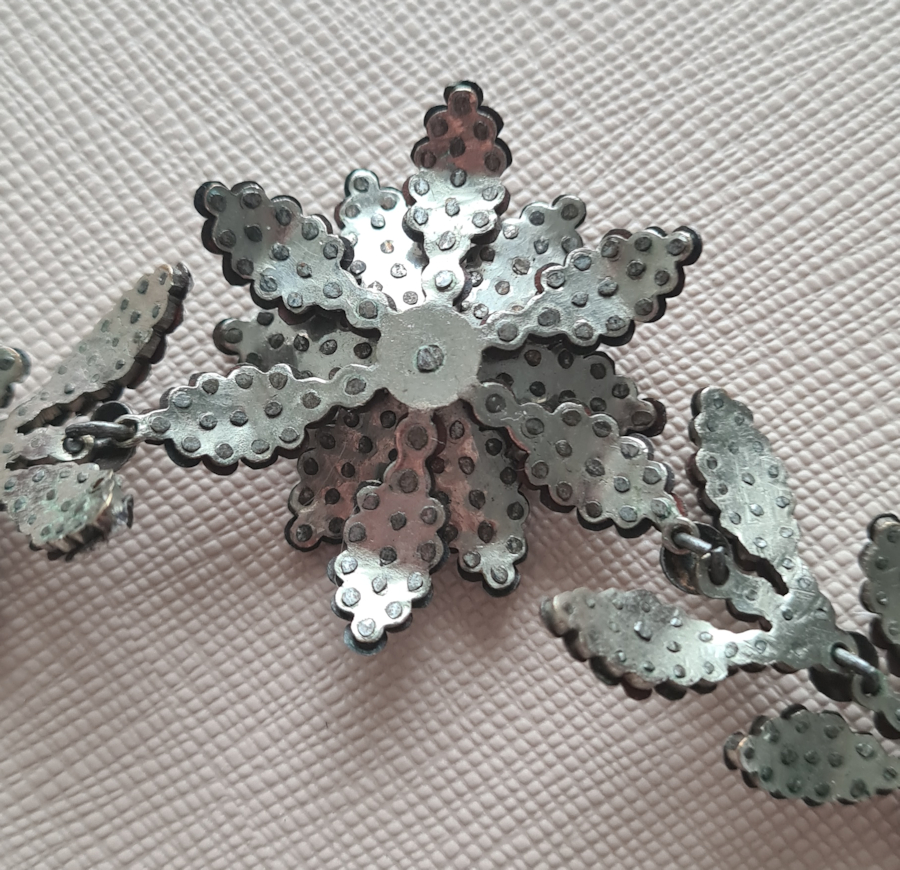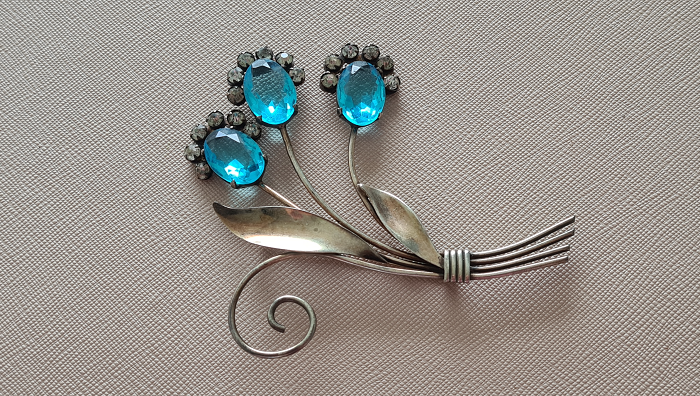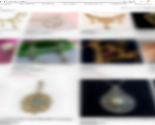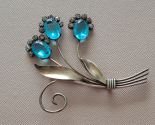
Cut Steel Jewellery
Cut steel jewellery is quite self-explanatory; it is jewellery made of bits of steel that has been cut (faceted) and riveted onto a steel base. There is debate over when the technique was developed, as it was mentioned as early as the late 16th century, but jewellery historians seem to agree that this early source most likely was talking about something else entirely, and that proper cut steel jewellery was an invention of the early 18th century, with manufacturing of shoe buckles dominating for most of the remainder of the century. Anne Clifford (see sources) suggests that shoe fashion moving away from buckles by the 1790s was at least partly responsible for the manufacturers turning their focus to jewellery, and cut steel jewellery would remain in fashion throughout the 19th century before production ceased around 1930.
Manufacturing
Cut steel jewellery was made in both England and France, with Matthew Boulton of Soho, Birmingham being the most well known. Boulton (1728-1809) cooperated with Josiah Wedgwood and created buttons, brooches, and other smaller items with Wedgwood jasper ware surrounded by a frame of cut steel. Both Birmingham and Oxfordshire would remain important sites for cut steel jewellery production after the market’s demand for shoe buckles decreased.
Creating anything out of cut steel was a labour intensive task. The base of the item would be cut or cast from steel. Depending on the kind of piece they were making, these bases could be single pieces or complicated designs made up of multiple pieces. Each piece would then have holes drilled for each individual stud. The studs were made of tiny balls of steel that had been faceted, and they’d then be riveted in place before the pieces were connected.

As the years went by, some manufacturers realised that they could get away with simplifying the process. Each part would be stamped out of metal (simplifying the manufacturing process greatly) and the number of facets, regardless of whether they were stamped or faceted and then riveted onto a base, was reduced from up to 15 to as few as 5. This would eventually contribute to the decline in popularity, as the simplified manufacturing process made the jewellery look way less appealing, and the reduced number of facets made them less glistening and gleaming in incandescent light.
Style and purpose
What made cut steel so appealing was, as mentioned above, how it would shine almost like diamonds in the glow from candlelight. Diamonds were of course hard to come by, and while paste was an option, cut steel offered the added bonus of being made from an affordable material (paste would be set in gold). This made it particularly practical for the well-to-do when they were travelling, but it was also considered suitable for day-wear, as it was considered less flashy, and the second stage of mourning.
Just like Bohemian garnet jewellery, cut steel jewellery was made up of tiny and closely set “stones”, providing tons of sparkle and a sense of opulence and grandeur, even if the material itself was not exclusive or expensive. Thus, we see some of the same design elements in certain types of jewellery, especially necklaces and brooches.
Rosettes and stars were quite popular, as were necklaces with a big three dimensional flower at the centre, surrounded by either foliage or smaller flowers on each side, with the remainder of the chain consisting of small rosettes.
Earrings, combs, hairpins and tiaras were also made with cut steel adornments, although they are harder to come by today.
Be mindful
As with all antique jewellery, there are some pitfalls, but also minor issues one should be mindful of when going on a shopping spree. First of all, make sure you are able to inspect the back of the piece (this goes for both online shopping and brick and mortar shops) to make sure the studs are actually riveted on.
Most pieces will be a tad darkened, but if it looks almost like oxidised silver, you are unlikely to be able to enjoy the wondrous sparkle it once had, and since moisture is the nemesis of cut steel, you don’t want to put yourself in a situation where you have to do a deep clean. Rust is much worse – it indicate that the piece of jewellery you’re considering has already been exposed to too high moisture, and there may be rust forming in parts of the jewellery that you cannot see (on the backside of studs, for instance. Rust eats away at iron and makes it brittle before it disintegrates entirely, and so even being able to clean off the rust will leave the steel damaged to some degree.
Remember to look closely at the studs. How many facets are there? More facets means more sparkle, higher value and an earlier manufacturing date. Look for missing studs and if there are any, take note of how visible they are.
Unfortunately, cut steel is a bit tricky to photograph, as the combination of the uniform colour and the multitude of reflective surfaces can result in the piece looking flat and blurred, as if the camera was out of focus or the piece was moving about when the picture was taken. If shopping online, don’t hesitate to ask the dealer for more photos if you are unsure of the state of the piece.
While the length of necklaces made from cut steel would vary depending on the fashions of the time, most of them are quite short by modern standards, as they were meant to be worn against the base of the throat. If you have a thicker neck, the necklace may simply be too small to be worn comfortably, and wearing it may even put too much strain on the links, damaging the necklace over time. Therefore, if the seller hasn’t provided you with information about the length, and you’re not able to try it on, you should probably ask about it and use a measuring tape to check how it would fit you. I have come across a couple of cut steel necklaces with a springring clasp, and while this is positively a modern alteration or repair, it does make it possible to add an extender chain to lengthen the necklace.
Although earrings were made from cut steel, many of the extant items on the market have been converted from other pieces of jewellery. If this is important to you, consider the following:
- Do the earrings match the trends of the time?
- Are the wires made of the same material?
- Are the wires consistent with the assumed age?
- Are there discoloration, scratches or other kinds of damage either at the top or the bottom of the earring that may indicate that it has been cut from a bigger piece?
Dating and valuation
Since steel is rarely hallmarked, it is difficult to identify where, when and by whom a piece of cut steel jewellery was made, but we can make educated guesses based on the manufacturing method and the style of the piece.
Needless to say, cut steel jewellery would adapt to trends just as any other jewellery, which can give us a clue. I have not managed to find an exact date for when the more crudely created pieces appeared on the market, but they were a Victorian creation, and so one can safely assume that anything with visible rivets on the back side is manufactured some time between c 1790 and 1850, most likely 1800 to 1840, and either Georgian or early Victorian, while pieces with no rivets (i.e. stamped) would be either high or late Victorian (or more modern).
Since steel will rust when exposed to humidity, a lot of cut steel has deteriorated over the years, and it is not unusual to find pieces on the market with visible rust spots. Another potential issue is missing studs, which, depending on the number and placement of the open holes, may make the piece look rather shoddy or not really matter at all. Still, any defects will of course reflect on the value.
Another factor is the rarity of the design. Novelty pieces or unusual designs are likely to catch a higher price than run of the mill designs.
Sources and further reading
- Wikipedia: Cut steel jewellery (citing Cut-Steel and Berlin Iron Jewellery by Anne Clifford)
- Antique and 20th Century Jewellery by Vivienne Becker
- Starting to Collect Antique Jewellery by John Benjamin
- Answers to Questions About Old Jewelry 1840-1950 by C. Jeanenne Bell







-
-
2 years
Tagged alloys, georgian, pinchbeck